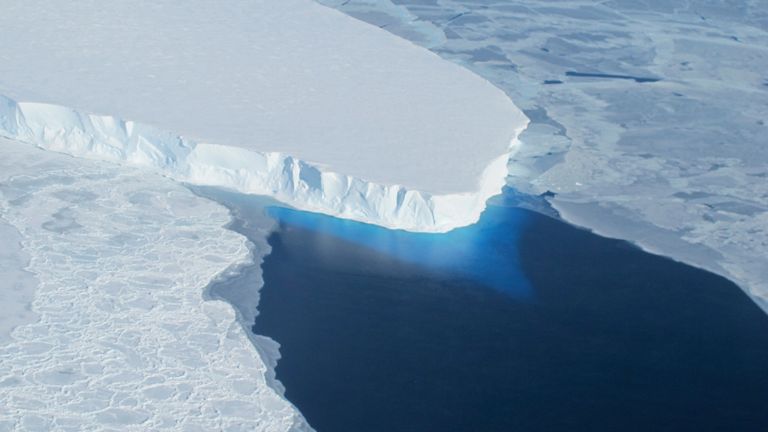If the Thwaites Glacier melted entirely, experts said it would raise sea levels by 3.3 metres, enough to put Westminster, Battersea and Canary Wharf underwater.
By Dylan Donnelly,
news reporter
Friday 20 September
Sky News


Explorer Shackleton's last ship discovered 'intact' on sea floor - as sonar image released

Applications open for Antarctica's penguin post office with one applicant using tattoos to show her enthusiasm

Bird flu found in king penguins for first time on islands near Antarctica
"However, there is also concern that additional processes revealed by recent studies, which are not yet well enough studied to be incorporated into large-scale models, could cause retreat to accelerate sooner."

Friday 20 September
Sky News

Experts now think much of the Thwaites Glacier could have melted by the 23rd century. Pic: PA
A massive ice sheet in Antarctica - equal to the size of Great Britain - could be all but lost by the 23rd century, experts warn.
The Thwaites Glacier is one of the largest and fastest-moving in the world. Along with the wider region - the Amundsen Sea Embayment - it accounts for 8% of the current rate of global sea level rise, at 4.6mm a year.
Experts from the International Thwaites Glacier Collaboration (ITGC) now say ice loss at the glacier will accelerate through the 22nd century and could lead to a widespread collapse of the West Antarctic Ice Sheet in the 23rd.
If it all melted, experts said the glacier would raise sea levels by 3.3 metres, or close to 10 feet.
Modelling from Climate Central - an independent group of scientists - holds that such a rise in sea level would put large parts of central London, including Westminster, Battersea and Canary Wharf, underwater.
"Thwaites has been retreating for more than 80 years, accelerating considerably over the past 30 years, and our findings indicate it is set to retreat further and faster," British Antarctic Survey (BAS) marine geophysicist Dr Rob Larter said.
The expert, also of Science Co-ordination of the ITGC, added: "There is a consensus that Thwaites Glacier retreat will accelerate sometime within the next century.
More on Antarctica
A massive ice sheet in Antarctica - equal to the size of Great Britain - could be all but lost by the 23rd century, experts warn.
The Thwaites Glacier is one of the largest and fastest-moving in the world. Along with the wider region - the Amundsen Sea Embayment - it accounts for 8% of the current rate of global sea level rise, at 4.6mm a year.
Experts from the International Thwaites Glacier Collaboration (ITGC) now say ice loss at the glacier will accelerate through the 22nd century and could lead to a widespread collapse of the West Antarctic Ice Sheet in the 23rd.
If it all melted, experts said the glacier would raise sea levels by 3.3 metres, or close to 10 feet.
Modelling from Climate Central - an independent group of scientists - holds that such a rise in sea level would put large parts of central London, including Westminster, Battersea and Canary Wharf, underwater.
"Thwaites has been retreating for more than 80 years, accelerating considerably over the past 30 years, and our findings indicate it is set to retreat further and faster," British Antarctic Survey (BAS) marine geophysicist Dr Rob Larter said.
The expert, also of Science Co-ordination of the ITGC, added: "There is a consensus that Thwaites Glacier retreat will accelerate sometime within the next century.
More on Antarctica

Explorer Shackleton's last ship discovered 'intact' on sea floor - as sonar image released

Applications open for Antarctica's penguin post office with one applicant using tattoos to show her enthusiasm

Bird flu found in king penguins for first time on islands near Antarctica
"However, there is also concern that additional processes revealed by recent studies, which are not yet well enough studied to be incorporated into large-scale models, could cause retreat to accelerate sooner."

Image:Pic: NASA
Thwaites Glacier rests on a bed far below sea level that slopes downwards towards the heart of West Antarctica, leaving it more vulnerable to rising sea temperatures.
It is roughly 120km across, making it the widest in the world, and in some places is more than 2,000 metres thick.
The researchers said they used underwater robots, new survey techniques, and new approaches to ice flow and fracture modelling to investigate the glacier.
While they acknowledge there is a lot unknown about the glacier's future, their results indicate the rate of ice loss from the retreating glacier will increase in response to climate and ocean changes.
The researchers added the Thwaites Eastern Ice Shelf - which currently covers around half of the 120km-wide front of the glacier - is likely to disintegrate in the coming decade.
Last year a group of scientists tasked by the UK Foreign Office to investigate "unprecedented" changes in Antarctica warned the disruption was not being taken seriously enough.
In March, scientists said they were designing a radical 62-mile long curtain to protect the glacier from being nibbled away by warm water beneath it, as it floats on the sea surface.
Thwaites Glacier rests on a bed far below sea level that slopes downwards towards the heart of West Antarctica, leaving it more vulnerable to rising sea temperatures.
It is roughly 120km across, making it the widest in the world, and in some places is more than 2,000 metres thick.
The researchers said they used underwater robots, new survey techniques, and new approaches to ice flow and fracture modelling to investigate the glacier.
While they acknowledge there is a lot unknown about the glacier's future, their results indicate the rate of ice loss from the retreating glacier will increase in response to climate and ocean changes.
The researchers added the Thwaites Eastern Ice Shelf - which currently covers around half of the 120km-wide front of the glacier - is likely to disintegrate in the coming decade.
Last year a group of scientists tasked by the UK Foreign Office to investigate "unprecedented" changes in Antarctica warned the disruption was not being taken seriously enough.
In March, scientists said they were designing a radical 62-mile long curtain to protect the glacier from being nibbled away by warm water beneath it, as it floats on the sea surface.
No comments:
Post a Comment